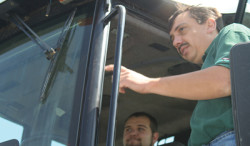Employee Management: 6 Steps To Achieve Knowledge Transfer

The Ag1Source consultants spend much of their winter at Ag Industry tradeshows and conferences. Every year, there is at least one industry problem or concern that tends to be discussed at each show we attend. This year, our article from the November issue of Croplife® magazine, “Thinking Ahead Today For Tomorrows Sake,” generated some good discussion along with concerns from many of the retailers we visited with. Most, if not all, agree with our plea to put a succession plan in place, yet struggle with how to actually pass on the knowledge and information to the future leaders.
The concept of passing along critical information from a departing employee to their successor or multiple people within an organization is more commonly known as Knowledge Transfer or KT. Knowledge transfer, at its simplest, is a written plan that includes a timeline to pass along each and every critical piece of knowledge held by a key employee.
We’ll dissect Knowledge Transfer into six basic steps in this article.
First, good knowledge transfer programs should clearly assess what knowledge needs to be transferred, and to which people within the business. As an example, we’ll use a CFO or top finance person within the business. Let’s say the example CFO is retiring in two years. The knowledge transfer assessment needs to include a clear list of WHAT knowledge needs to be brainstormed, collected and prioritized. This list needs to include items such as how to interface with the auditor and board, clear understanding of the accounting controls and measures, sharing current strategies and activities related to growth and assisting in the due diligence for past projects. If you want the next CFO to be 100% functional in two years, they need to be informed of what you are doing and why you are doing it. This valuable information may include letting them in on a business secret such as potential standing offers from other businesses that may be interested in one of your locations or a property that they have been keeping an eye on. The key thing to remember is to make an exhaustive list of the knowledge and prioritize it.
In the second step, take the prioritized list and assign it to people throughout the organization. As names are assigned, it is typical that 90% of the knowledge needs to be passed to the successor, but there will be other key players that will need some of the information. For example, is there value in department managers gaining insight into some of these details? Has the current CFO missed opportunities to delegate information and responsibilities to existing accounting staff?
With the key information identified and assigned to its recipient, it’s time for the third step — build a delivery timeline. If the CFO’s eventual retirement is two years out, the process will provide two business cycles to pass along the information needed, as it is happening in real-time business. A more simple way to look at this may be for the CFO to “work” each task or project with the knowledge recipient watching for the first year and for the recipient to “work” each task or project with the exiting CFO watching and coaching in the second year.
As with any set of goals or objectives, the plan needs the fourth step, which is making each goal measurable. For example, one goal could be related to the company’s insurance plans and polices. The departing CFO could be given the goal to go through all current insurance contracts with the insurance broker and make sure their replacement has a full grasp on all policies by a set date. This goal is complete when the new CFO is comfortable with the information learned through the process and is ready to take over this vendor relationship.
Keeping It Simple
So far, this is a fairly good plan in place for Knowledge Transfer. The fifth point, however, is to take a breath, re-evaluate the plan and make sure it is simple. If the end result includes 100 pieces of knowledge that need to be transferred, do some pieces need to be removed because they are repetitive? Perhaps some of the knowledge can be acquired through the hiring of a replacement. Given the running example as a CFO, maybe it is best to find a candidate to back-fill the role that will start as a controller, but has deep prior experience as a CFO in a smaller organization. Keep the plan simple and focused and it’s more likely to be followed. Many experts in the field of Knowledge Transfer talk about how some organizations think the departing employee may be too busy to take the time to pass along the knowledge. If the plan is well built and simple, then they should be able to make the time to get it done.
The last step or concept to knowledge transfer may be the most difficult, and it is to make transferring knowledge a piece of the company’s culture. As we’ve pointed out in other articles, half of the workforce in agriculture is from the “boomer” generation and most will be retiring within the next 10 years. With this much of an exodus of the current staff, the need to build a culture of knowledge transfer on a daily basis is needed. Waiting until someone gives a two-week notice, or a one-year retirement notice is not the ideal time to get this process started.
Consider challenging each person on your management team to build their own knowledge transfer outline. What are the items they feel are critical to pass on if they were to change roles? What items do they list as critical to do their job day one, and what would be necessary to learn within the first year to be successful? Asking your managers to take this step will not only give them insight into what would need to take place should they need to replace themselves, but will be a giant step in helping your organization recognize what it takes to develop a sustainable culture.
While the process outlined above is more critical for senior roles within an organization, this method can be used all the way down the line to develop a culture of continual learning, and transitioning of the institutional knowledge needed every day from your grizzled veterans to your newest team members.






